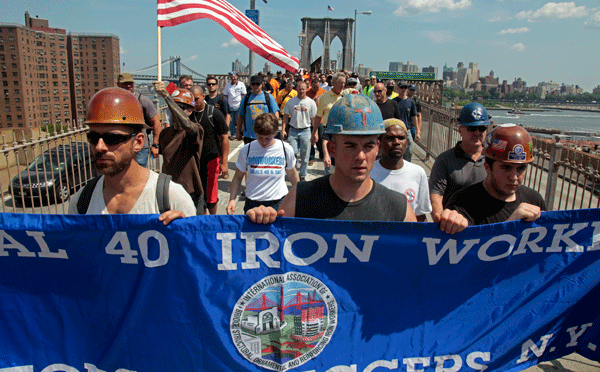
As Unions Weaken So Does the Middle Class
New Census Data Shows the Importance of Unions to the Middle Class
David Madland and Nick Bunker parse the latest figures to show states with weak unions also share another trait—a weak middle class.
Media Contact
Government Affairs

New state income data released yesterday by the U.S. Census Bureau shows the importance of unions to boosting incomes for all middle-class households—union and nonunion alike. The 2010 income data makes it clear that strong unions are a critical factor in creating a middle-class society. Restoring the strength of unions would go a long way toward rebuilding the middle class.
The states with the lowest percentage of workers in unions—North Carolina, Georgia, Arkansas, Louisiana, Mississippi, South Carolina, Tennessee, Virginia, Oklahoma, and Texas—all have relatively weak middle classes. In each of these states, the share of income going to the middle class (the middle 60 percent of the population by income) is below the national average, according to Census Bureau figures.
Mapping the Census data that has been released this fall to previous years also shows that over time the strength of the middle class and the strength of the union movement have tracked closely together. In 1968, the share of income going to the nation’s middle class was 53.2 percent, when 28 percent of all workers were members of unions. Since then, union membership steadily declined alongside the share of income going to the middle class. By 2010, the middle class only received 46.5 percent of income as union membership dropped to less than 12 percent of workers.
As unions weakened, the lion’s share of the economy’s gains have gone to the wealthy. The share of pretax income earned by the richest 1 percent of Americans more than doubled between 1974 and 2007, climbing to 23 percent from 9 percent. And for the richest of the rich—the top 0.1 percent—the gains have been even more astronomical. Their share of income quadrupled over this period, rising to 12.3 percent of all income from 2.7 percent.
Without strong unions, the middle class has lost out to the wealthy.
To be sure, unions can sometimes act in an overly self-interested manner. But the core of what they do helps all workers and fuels a strong middle class. Unions make the middle class stronger by giving it a bigger say in our economy and our political system.
Unions increase wages for their members as well as raise standards and therefore increase wages for nonmembers. They also ensure that workers are considered in corporate decision-making, and provide job training that help workers advance in their careers. In the political arena, unions get workers involved to boost voting rates, and are champions of economic programs that create a strong middle class. They pushed for and have defended Social Security, Medicare, family leave, the minimum wage, and more recent policies such as health care reform.
In fact, dollar for dollar, strengthening unions is just about as important to the middle class as boosting college graduation rates, according to a study we conducted several months ago on the strength of the middle class in all 50 states and updated for this column based on the new Census figures. In our analysis we control for a variety of other factors that might also affect the strength of the middle class: education levels, unemployment rate, and industry composition. This enables us to assess the influence of unions by holding constant the effects of these other factors.
The table below shows the state-by-state impact of unions on income. If unionization rates increased by 10 percentage points—to roughly the level they were in 1980—the typical middle-class household, unionized or not, would earn $1,479 more a year.
To put that number in context, increasing college attainment rates by 10 percentage points would boost middle-class incomes by $1,638. Similarly, decreasing unemployment rates by 4 percentage points—bringing rates down to pre-Great Recession levels—would increase household income by $772 per household.
Our findings are consistent not just with our previous research, but also with a large body of academic research. Just last month, an article by Harvard’s Bruce Western and the University of Washington’s Jake Rosenfeld found that the decline of unions accounts for one-third of the rise in economic inequality in the United States over the past 30 years.
Even before the Great Recession, the middle class was struggling. Yet we can rebuild the middle class. It won’t be easy, and will require a range of solutions. But one thing is clear—stronger unions make a stronger middle class. And a strong middle class is the foundation for a vibrant American economy.

Dr. David Madland is the Director of the American Worker Project at American Progress and Nick Bunker is a Special Assistant with the Economic Policy team at American Progress.
See also:
The positions of American Progress, and our policy experts, are independent, and the findings and conclusions presented are those of American Progress alone. A full list of supporters is available here. American Progress would like to acknowledge the many generous supporters who make our work possible.
Authors

Nick Bunker
Research Associate


